Chair of Pharmacology
Chair of Pharmacology
Head: Professor Rafał Olszanecki M.D., Ph.D.
email: rafal.olszanecki@uj.edu.pl
Grzegórzecka 16, 31-531 Kraków
tel. (012) 421 1168, fax. (012) 4 217 217
Staff: strictly scientific: 16, others: 17
Structure
Department of Pharmacology
Head: Professor Rafał Olszanecki M.D., PhD
Department of Clinical Pharmacology
Śniadeckich 10, 31-531 Kraków, tel. (012) 428 4740
Acting Head: Dr hab. Jarosław Woroń
e-mail: j.woron@uj.edu.pl
Historical note
Chair of Pharmacology of Jagiellonian University was founded in 1818, mainly for teaching Materia Medica, but also pharmacy, toxicology, hygiene and forensic medicine. The first chairman Professor W.J. Boduszyński (1818-1832) was followed by Professor A. Jakubowski (1832-1833) and then Professor P.K. Skobel (1833-1876). After internal transformation pharmacological sciences were incorporated within the Chair of Pharmacognosy under the leadership of Professor J. Łazarski (1882-1924). In 1922 the Chair of Pharmacology emerged again from the Chair of Pharmacognosy and until 1928 it remained under the leadership of several clinicians. Then it gained the outstanding chairman Professor Janusz Supniewski who, apart from a war break (1939-1945), was its leader since 1964 comprising research and teaching in pharmacology at the Jagiellonian University in Krakow. In 1965 Professor Ryszard Gryglewski took over and Chair of Pharmacology has remained under his outstanding leadership till 2002 when Professor Gryglewski retired. Department of Clinical Pharmacology was created in 1979 with Professor Elżbieta Kostka-Trąbka as a chairman. She retired in 2000. After a transient one year-long period of Professor Lilia Grodzińska as a chairmen, from 2003 Chair of Pharmacology was took over by Professor Ryszard Korbut, close associate of his noble predecessor for more then 30 years. Starting from 2002, Chair of Pharmacology include the following parts: Department of Pharmacology, Department of Experimental Pharmacology, Department of Clinical Pharmacology and Laboratory of Molecular Pharmacology.
Scientific achievements
Proposal of dissociation between mechanical and metabolic cardiac effects of adrenolytic drugs. Discovery of fibrinolysis by of biarylcarboxylates. Discovery that glucocorticosteroids inhibit the release of arachidonate from membrane phospholipids by inhibiting activity of phospholipase A2. A concept of compartmentalization of generation of eicosanoids in the lung. A concept of endocrine-like function of the lung. A hypothesis that atherosclerosis is a disease from prostacyclin deficiency that is caused by overproduction of lipid peroxides. Clinical trials with prostacyclin, prostaglandin E1 and NO-donors in peripheral vascular disease. Studies on fibrinolytic action of prostacyclin, nitric oxide (NO) and their releasers such as pyridyl-carbinol, kallikrein or camonagrel. Discovery of a new pyrane product of prostacyclin hydrolysis (SMX). Discovery that superoxides selectively destroy EDRF (NO) (endothelium-derived relaxing factor). Studies on the differential synergistic interaction of prostacyclin and NO at the level of leukocytes, platelets and blood vessels. A hypothesis on a combined NO/adenosine-mediated mechanism of myocardial reactive hyperemia. Studies on ebselen and other selenoorganic compounds as inhibitors of activity of an isoform NO synthase (NOS). Studies on bioflavonoids as superoxide scavengers. Experimental demonstration of paradox of thrombogenesis by streptokinase. Discovery of endothelial action of thienopyridines leading to their platelet-independent thrombolytic effect. Elucidation of the role of coronary artery superoxide production and Nox isoform expression in human coronary artery disease.
Current topics
- Mechanisms of action of cardiovascular drugs such as statins ACE-I, β-adrenoceptor antagonists, flavonoids, thienopyridins and others.
- Molecular characterization of COX-products in cultured endothelium
- Interactions between nitric oxide, carbon monoxide and COX products in endothelium
- Role of endothelial mediators in erythrocyte deformability
- Mechanisms of endothelial dysfunction in diabetes and hypertriglycerydemia
- Role of endothelial dysfunction in progression of heart failure and atherosclerosis in genetically modified mice model of these diseases (Tgαq*44, ApoE/LDLR-/- mice)
- Role of leukotrienes in atherosclerosis in ApoE/LDLR-/- mice
- Role of NADPH oxidase in endothelial dysfunction in human coronary vessels and in animal model of hypertension.
- Protective effect of endogenous and exogenous NO in septic shock
- Anti-platelet effect of S-nitrosothiols and CO releasing compounds
- Pathways of angiotensin I conversion in the vessel wall
- Genetic determinants of therapeutic response and adverse effects of oral hypoglycemic agents and insulin in patients with type 2 diabetes

